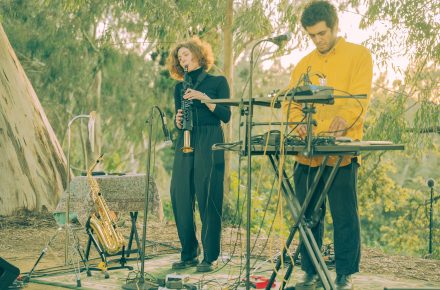This guest mix is courtesy of Daniel Diako, founder of the experimental music project Environmental Studies based in Los Angeles. Diako provided Ajam Media Collective with a mix of artists he considers influences and contemporaries, and below, offered a brief interview with Ajam in order to explore the Persianate roots of his sound.
In this mix, Environmental Studies presents some original music alongside a range of far out and at times ambient sounds, ranging from electronic, to folk inspired, to minimalist and lo-fi tracks. You can stream and share the mix here. Follow the project on Instagram for information on new releases and performances.
Followers of minimal synth music have come to expect certain hallmarks from the hard-to-categorize genre, whether it be its European pedigree, extensive use of synthesizers and drum machines, repetitive structures, or a “cold” production style emphasizing artificiality and the “synthesized” nature of the sound. Minimal synth music has an infectious appeal for a generation that grew up with electronic music, as it offers stripped-down soundscapes, merging vintage analog tones with a contemporary grit. The genre’s hypnotic, repetitive rhythms and shimmering textures create an immersive and at times nostalgic experience that resonates with both retro enthusiasts and modern listeners alike.
Environmental Studies’ 2022 release The Moviegoer was a surprising and curious entry into this genre. The self-produced and self-released album fused the scene’s European emphasis on synthesizers with an expanded range of Iranian vocal samples, cinematic ambiance, nature sounds, warm lo-fi production, and worldly instrumentation that is typically underrepresented in the genre. The result is a mix of electronica that feels both futuristic and retro at the same time – like someone took a cross section of Iranian popular music from the 70s and gave it the dub reggae production treatment.
What struck me upon my first listen and even first glance at the track list was the clear Iranian and Persianate influence throughout the album. Samples of pre-Revolutionary Iranian radio and classical music recordings give the album a transportative, nostalgic quality. Track titles like “Lehzat” and “Arezoo” signal a clear element of cultural interplay at work.
Environmental Studies is a project masterminded by Los Angeles-based Daniel Diako, who brings on collaborators for live performance and occasional studio sessions. Diako’s background growing up in the Iranian-American diaspora in Los Angeles offers some clues into these cultural influences. The Moviegoer attributes much of the vocal samples to the artist finding his father’s cassette collection from Iran, largely recorded in the years immediately preceding the Revolution.
The mid-to-late 70s saw an explosion in cassette recording becoming more accessible to Iranian consumers. As Diako tells it, if radio and television were his father’s passport to the rest of the world, tapes were the souvenirs of his journeys. Armed with this new, affordable recording technology, his father began recording anything that piqued his curiosity, including DJ monologues, radio plays, movie dialogue, and spoken word translations of European pop played on late night radio programs like Yad-e Dirooz. It was only when his father asked him to digitize these cassettes some fifty years later that the concept for the record began to emerge.
To help place this album in its historical and musical context, Ajam asked Environmental Studies to provide a mix showcasing the context of his work and engage in a brief discussion about the exotica music of the 1950s and 60s, the complications of diaspora identity, and the origins of the album’s unique soundscape.

Ajam: Environmental Studies is a project that emerged in the midst of this larger and very diverse scene of experimental synth-based electronic music. The last twenty years or so have seen an explosion in reissue labels rediscovering obscure records and tapes from the late 70s and early 80s, with Europe, Japan, and North America at the center of it all. New artists, influenced by these sounds, have picked up the mantle of the genre, but very rarely does Iran enter the conversation. When it comes to you as an individual, where do you trace your desire to make this kind of music?
Environmental Studies: This project emerged from some of my intersecting musical obsessions. It combines elements of exotica music of the late ’50s and early ’60s—artists like Martin Denny and Les Baxter—with European synth music of the 80s, industrial music and pre-revolutionary Iranian cinema. I was intrigued by how these elements could merge to create a sense of place through sound.
Ajam: Exotica–now that is a genre name I haven’t heard in a while. For our readers, can you provide a bit more context?
Environmental Studies: I use the word playfully, because I think it’s a word that should be played with. Traditionally, the genre name arose in the 1950s as a marketing term to refer to what people now think of as kitschy lounge music for Tiki bars. There’s a cultural awkwardness around the term that is well-deserved and, at the same time, compelling. But exotica, to me, simply means the music of an imagined elsewhere, somewhere you don’t happen to be. It creates imaginary places conjured through false memories. If we think back to Martin Denny’s records for example, I love those records, but they have nothing to do with, say, Polynesian culture. They were made here in Los Angeles. It’s an evocation of a world that by definition cannot truly exist. I wanted to see if I could do something similar with my own colliding obsessions.
Ajam: That feels like an apt metaphor for the experience of being part of a diaspora, deterritorialized from the place the culture came from. But that strikes me as a unique take on exotica. It seems as if the project has a little bit of a self-orientalizing practice with a wink and a nod–because it’s a bit funny to create exotica while having roots in the “exotic” place in question.
Environmental Studies: If we go back to the idea of exotica as conjuring a place from a false memory, I would say this is me trying to conjure Iran as this place that I haven’t been able to visit, for a variety of reasons. It’s a place I could only and have only ever accessed through sound and through image. Through movies, music, books, objects, and through people. And through other people’s memories, but not my memories, right? And so it always remains on this level of abstraction, which is what exotica is. if you listen to the album, I doubt you’re going to come away going, wow, what an interesting re-orientalization project. You’ll come away with a real sense of genuine feeling – not an intellectual exercise.
Ajam: The album’s liner notes mention that your father’s cassette collection helped spark the project. Can you tell me a bit more about that?
Environmental Studies: My dad shared with me this suitcase of cassettes that he had recorded in the early 70s in Iran. And he would record all types of things. Movies, radio shows, commercials. But the main thing he recorded was these radio shows that would showcase European and American music. And it would be this DJ introducing these songs and then giving these broken translations of western music. And so here I was some 50 years later, almost trying to retrace his steps from the opposite direction.
Ajam: Do you feel your identity was top of mind when you were making the music? Were you saying, oh I’m engaging with Persianate, Iranian material as a member of this country’s diaspora? Or was it more a dialogue with your family experience and personal experience?
Environmental Studies: I would never claim to speak for or represent anyone else. But without trying to represent anything, I think I was absolutely speaking to and extending a hand and a gesture towards our community. There are artists like Vox Populi that really paved the way for Persian minimal synth, industrial sort of music. But it has to start from a personal place.
That’s why this project isn’t some intellectual exercise or self-orientalization. When I call it a reclamation project it’s almost a reclamation of these very real, familial memories. I think it would be very immediately clear and uninteresting to try to conjure an entire nation or entire people. But if you can try to just conjure a certain memory or a certain room or environment, then you can hopefully reach something authentic. And I’m hoping that the recordings begin to approach something like that.











